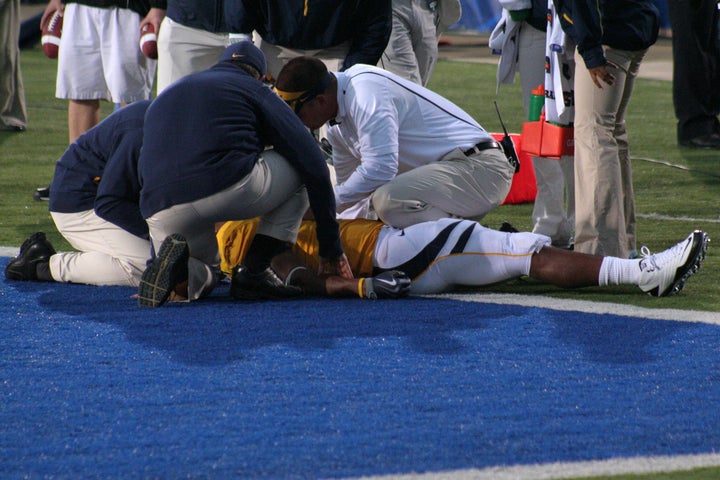
A player is examined for a concussion on the field.
Last year, The Huffington Post wrote that “The NFL Has A Quarterback Concussion Problem.” They were right. Quarterbacks like Matt Moore in Miami, who missed only one play before returning to the game, even after showing all of the signs of a concussion. Not only is this a danger to players and teams but the league’s reputation.
Recently, the Supreme Court declined to review a $1 billion dollar concussion settlement against the NFL. This season, the NFL instituted new rules that would fine teams and even cause them to lose draft picks if they failed to follow the concussion policy. It seemed like they were trying to follow the advice youth football coaches hear all the time: “when in doubt, leave him out.”
However, is it working? The tension has always been between the need to run spectacular plays to get and keep fan’s attention, and the desire to protect players. Because football is a game of passion, players push themselves to play through injuries, including concussions. Is the NFL protocol enough?
Number Of Concussions Diagnosed
The number of concussions diagnosed is on the rise in the NFL, but most likely this is due to stricter protocols and the current spotlight on head injuries. In the 2015 season there were 271 concussions diagnosed, up 31 percent from the previous year.
Coaching vs. Athlete Health
It comes down to the fact that coaches don’t want to sit athletes down who don’t want to sit. They don’t want to compromise a game, especially one in the playoffs by making a player go through an evaluation who tells the coach “I’m good to go.”
It’s not just about coaches keeping star players in the game either. It’s about the types of plays they call and the kind of offense they run.
Masaru Teramoto, the lead researcher in a study that appeared in Orthopedic Journal of Sports Medicine, had set out to see if there was a difference in the way players performed before and after they returned from concussions. Instead, he found that there was a statistically significant relationship between a team’s style of play and the number of head injuries the team reported.
“In the NFL, players most involved in pass plays appear to be at increased risk for concussions,” the study found. Beyond that, the type of pass plays called also plays a role. Short passes and crossing patterns put both defensive and offensive players at the highest risk.
This is backed up by the research of Charles W. Scouten, Ph.D, and his research on neurotrauma from impact in animal subjects. “It’s not about force,” he explains. “That is the wrong question. It is more about velocity and momentum.”
All of this makes for more spectacular numbers and more exciting games. As the pros become more pass focused so do colleges, high schools, and even middle schools. Players at all levels are at higher risk for concussions because of play calling at the same time we try to protect them with new protocols, awareness, and better equipment.
The Fault Is In Our Fans?
Many things are not what they seem, and we have been inundated with fake news, but we still have an astounding amount of trust in the NFL. “When in doubt, leave them out” should be the concussion motto, and the case of Matt Moore only proves the point. CBS analyst Phil Simms stated from the broadcast booth, “They would not let him back in the game if there was any doubt.”
That hasn’t been our experience as fans though, and while we want our favorite players to be safe, we like it when they power through injuries, and most of all when our team wins. If a coach benches a player as a precaution, we slaughter him with Monday morning quarterbacking. It works the same way if a coach lets a player continue to play, and their injury gets worse.
Coaches call big pass plays because it keeps them employed, and makes them seem like heroes in the eyes of fans, team owners, other coaches, and even players.
So Is It Working?
What does all of this mean to the future of football? How much stricter can we make concussion protocols and the fines and penalties for violating them? How safe can we make what is inherently a dangerous game?
The numbers say more concussions are being diagnosed and treated. Players are more aware, and the outcry after Carolina Panthers linebacker Luke Kuechly’s latest concussion that he should perhaps consider retirement is a discussion that probably would not have taken place at all a decade ago.
Football will always be a dangerous sport, and there is nothing we can do to change that. Through better protocols and more strict enforcement of those protective measures we can mitigate the danger to the long term health of players.
The way coaches coach and players play will always depend in large part on the fans, and how we respond to that style. Are the concussion protocols working? WIll they continue to do so?
Only time will tell. Read a more detailed look at concussions in the original article on Last Word on Sports.
